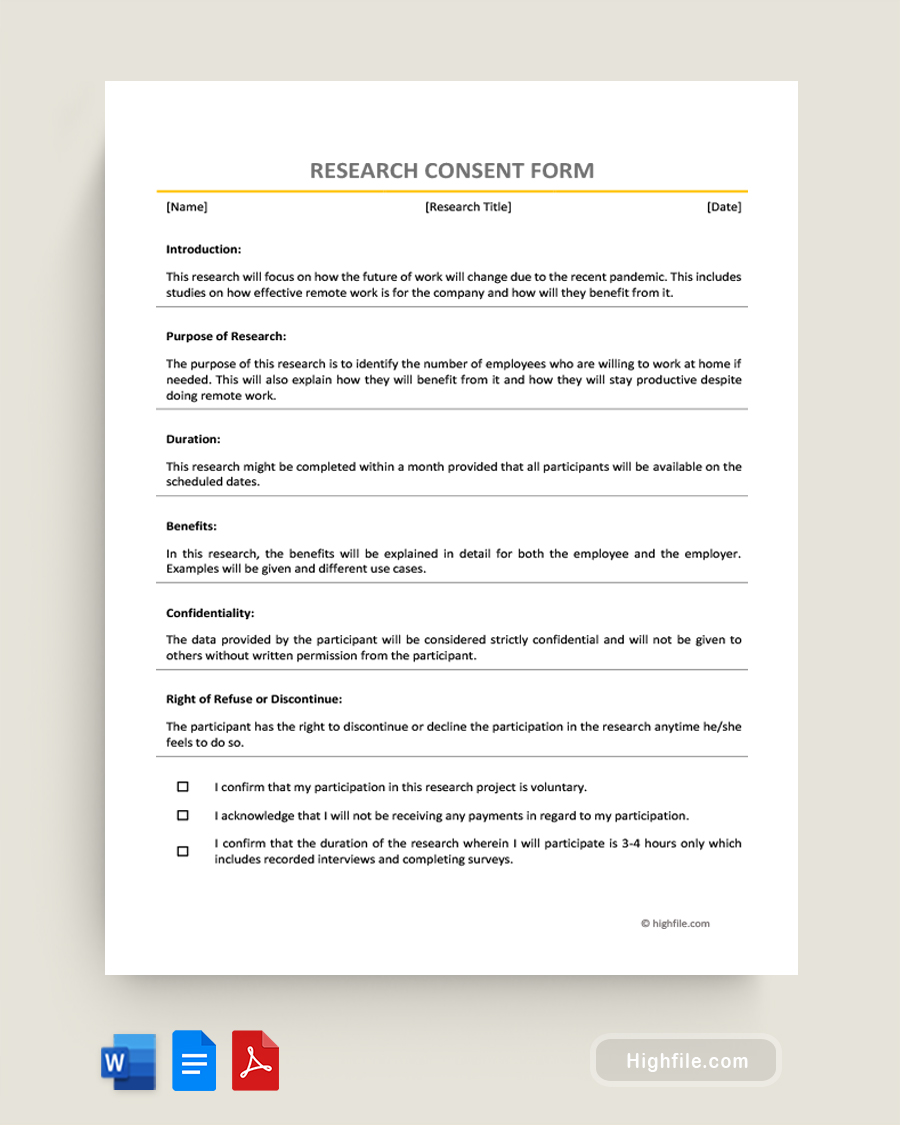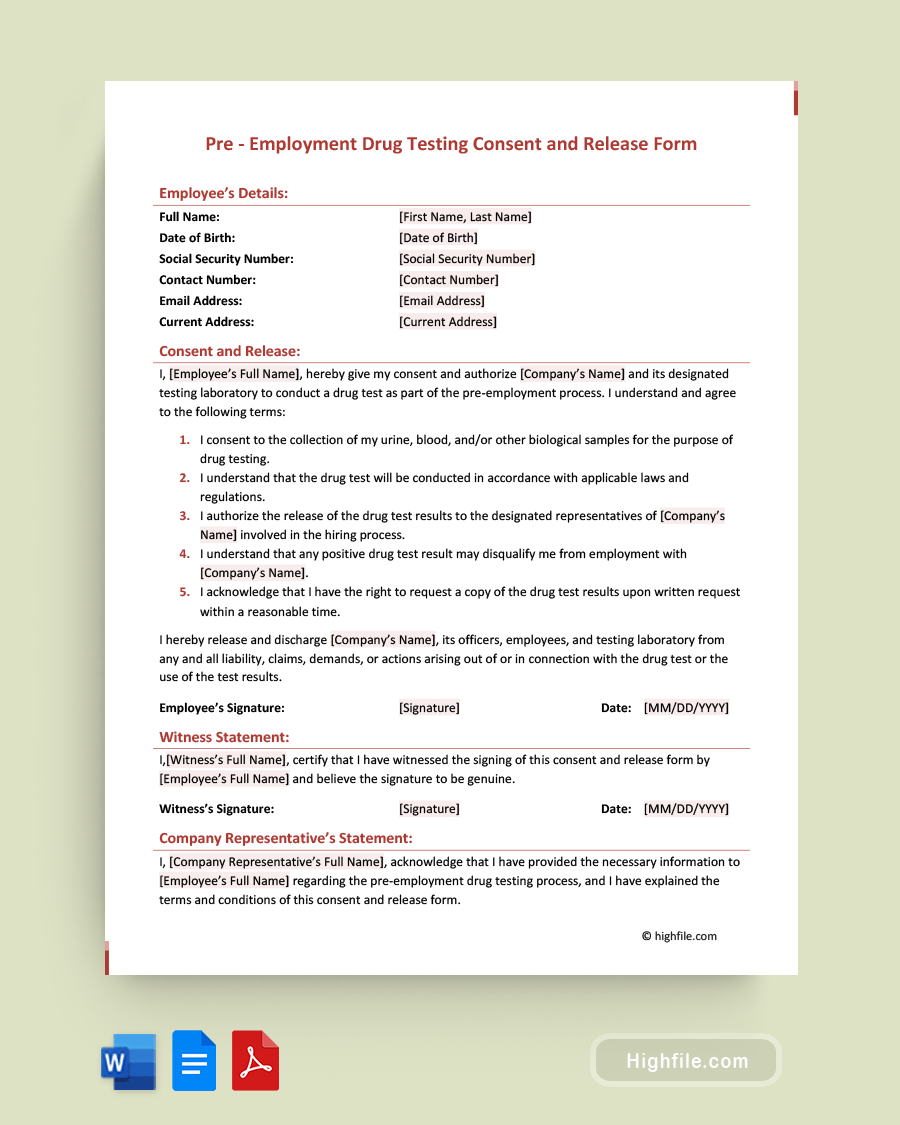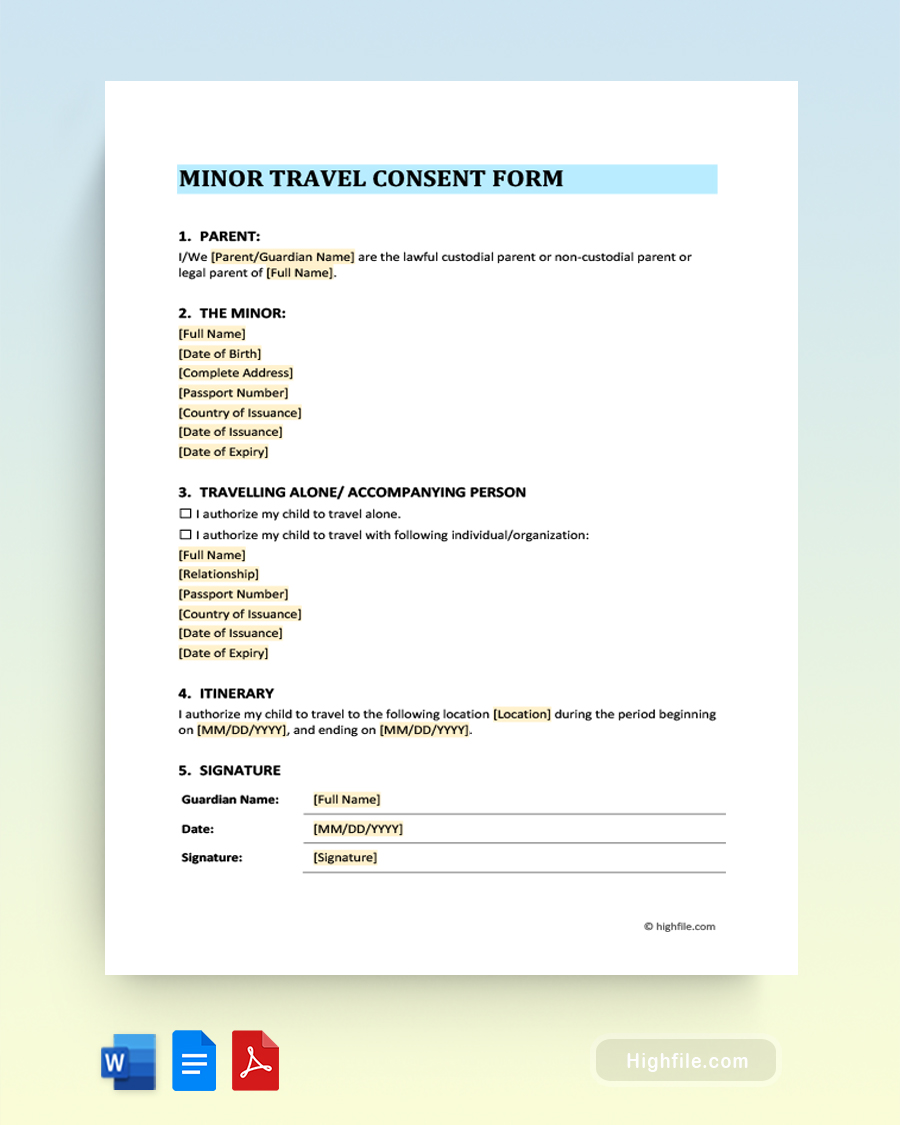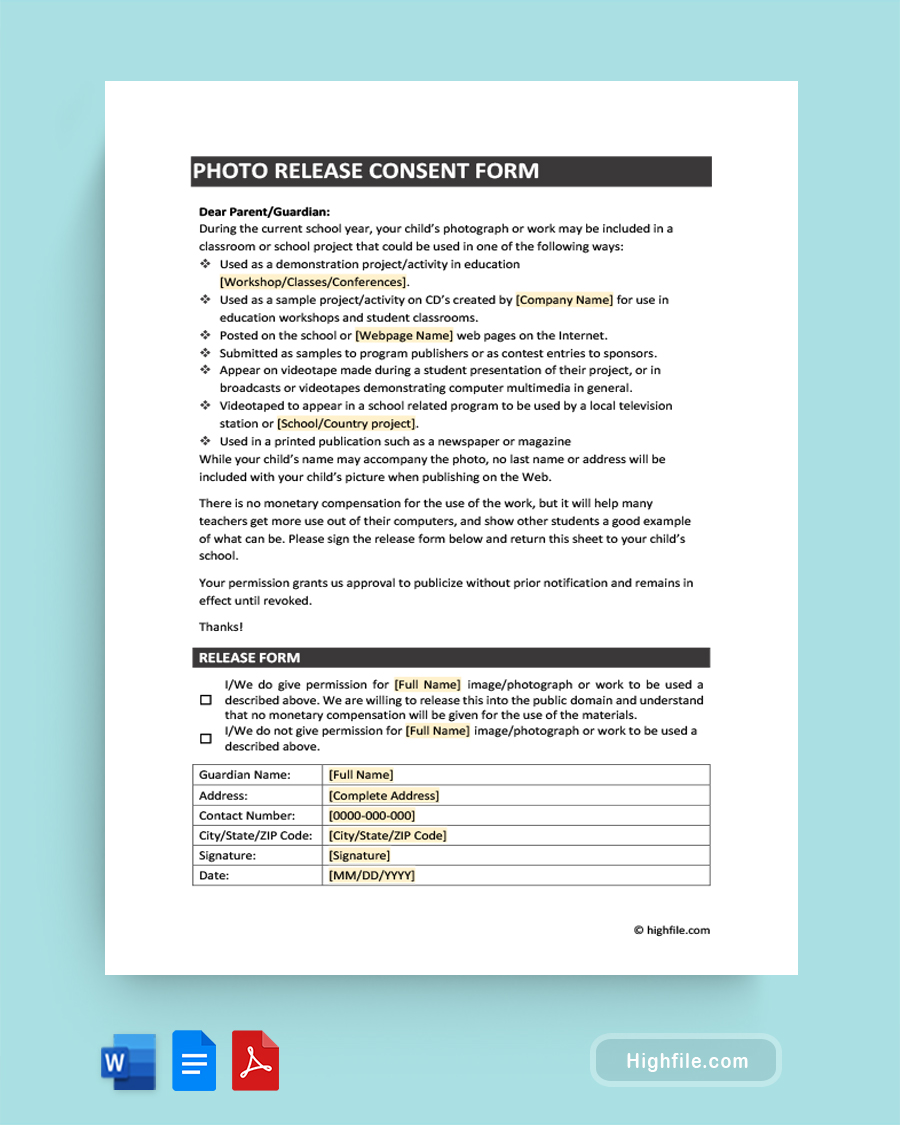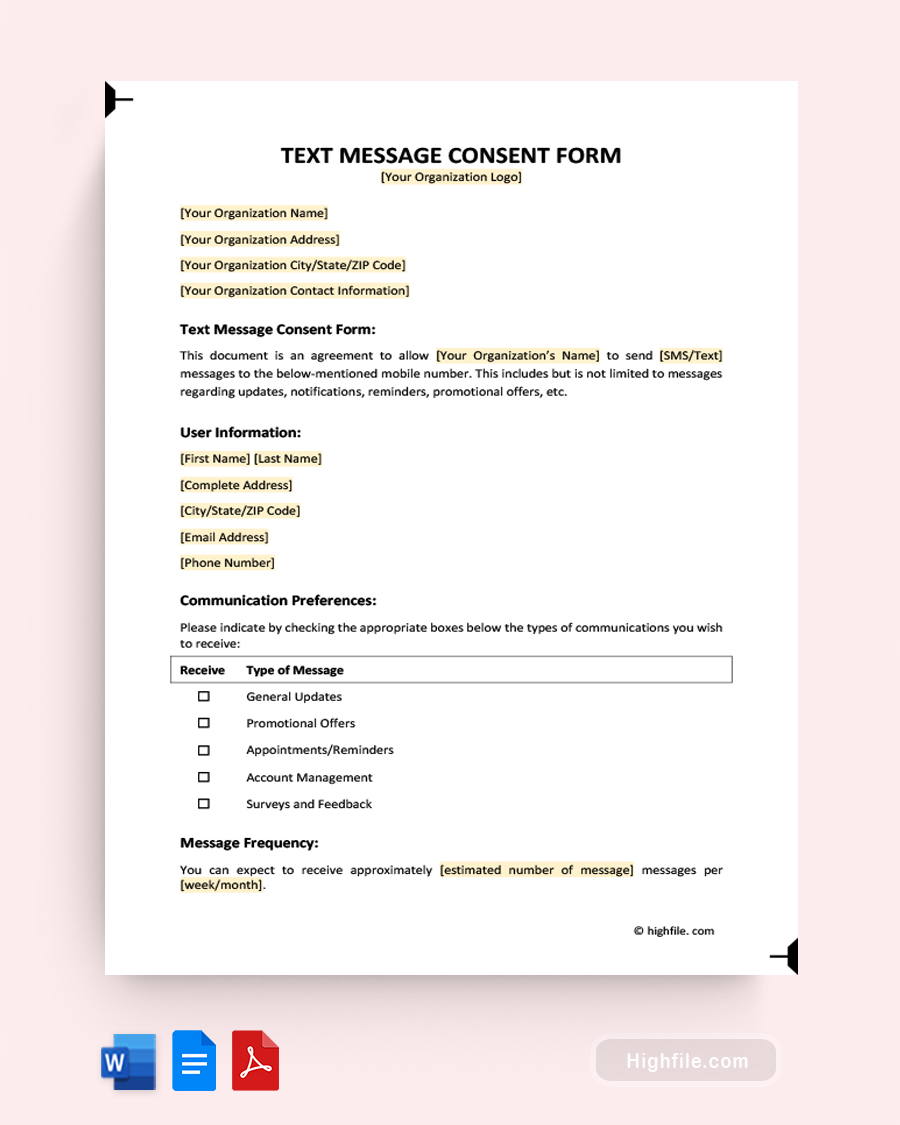Scientific research helps us understand our world, our bodies, medicines, and so much more. Without it, we, as a species, would not be able to accomplish half of what we do every day. Sound research is the backbone of innovation. However, not all research is created equal. While there’s little concern about experimenting on inert, inanimate objects, some things are more volatile. Researching humans is even more complex and nuanced. Even when you are extremely cautious, someone could get hurt. That’s where a consent form for research comes in. If you plan to research anything involving human subjects, you will need a template for this vital document.
What Is a Consent Form for Research?
A consent form for research is a form that study participants must fill out. This essential required document shows that the subjects understand potential risks, are aware of their part in the research, and, most importantly, the signature proves they consented to participate. All research participants must agree without being unduly coerced or tempted. However, in a few special circumstances, a consent form for research can be waived or intentionally edited to omit information that could skew the results.
Why is Research Consent Form Required?
Most studies and research require a research consent form, but why? Below, we’ve listed the reasons for this vital document. Some explanations are common sense, while others may surprise you, but all of these considerations go into creating and requiring this unique type of consent form.
- Evidence of Oversight- Having a research consent form shows that the study creators answer to an oversight committee and are not merely choosing to do random experiments on human subjects without permission or due diligence.
- Safety- There are some risks associated with most research, even if it is only minor discomfort, possible allergic reactions, and emotional upset. For the safety of participants, they need to be informed of any potential risks. Doing this is more than a courtesy. It is the ‘informed’ part of informed consent. You cannot decide whether you want to be involved without knowing what might occur.
- Understanding- In addition to simply providing the safety information, the researchers are responsible for ensuring all participants understand what they are being told. Sometimes this involves a personal one-on-one sit-down conversation; others, it means providing a contact phone number for people to call if they have questions. Either way, the participants are given every chance to ensure their own comprehension.
- Risk Assessment- With understanding comes the ability to assess the risk versus reward in a situation. An informed party can decide if they feel the good the study will do is worth participating in. Even when the stakes aren’t extensive, each individual should be allowed to choose for themselves whether the potential adverse outcomes are valuable enough to warrant consent.
- Potential Outcomes- A research consent form should contain information on all the potential outcomes. Both positive and negative results should be listed, along with any known side effects.
- Ethical Process- Another reason you should always require a research consent form is to show that the researcher(s) have done their due diligence and are actively involved in ethical research processes and practices.
- Researcher Protection- Doing research is, by its very nature, risky. In order to protect the researchers from fault for not providing the subjects with enough information and the opportunity to consent, this form is a must-have. A participant who knows the possible dangers and agrees to undergo the process cannot usually sue if they dislike the outcome.
- Clear Documentation (Paper Trail)- Keeping records is a critical aspect of research. Hence, collecting a research consent form from every participant is a practical part of the process and should always be included in your ‘paper trail.’
- Nondisclosure Agreements (NDAs)- Many studies ask the subjects to keep information private. A research consent form offers a place to include a nondisclosure statement which binds the participants from sharing your research processes and other data with anyone.
- Future Considerations- Although many studies are straightforward and have no risks or side effects to be concerned about once the process is complete, you never know. Keeping the consent forms allows you to do follow-ups and future research on the participants.
Does all Research Require Informed Consent?
All research does not require informed consent. While it is true that, as a general rule, almost all research does need informed consent, there are some instances where this may be waived. For example, when the research presents no or minimal risk, there may not be a need to acquire written consent. When your study does not affect the health or welfare of the subjects, and a lack of waiver won’t impact the subject’s rights, you may proceed without the forms.
For example, if you are studying the eating habits of local university students, you would need informed consent to ask those students what they eat each day. However, you might be able to get a waiver for the consent if you instead intended to count the number of commissary meals and portions served. Since no individual’s rights or data would be collected in the latter case, and you would presumably have the school and/or commissary permission to make these counts, it’s less likely that you’d need every individual student to consent.
Determining Whether a Consent For Research Form Is Necessary
Most of the time, you cannot simply decide to perform research on people on a whim. Especially when the research is biomedical or may impact people’s physical or psychological health, oversight is mandatory. The FDA requires an IRB or Institutional Review Board to monitor and review studies involving human subjects. Any time a study involves something that the FDA regulates, that study requires an IRB, which can determine whether informed consent is necessary and review requests to modify or waive consent forms.
Prisoner Research and Informed Consent
It is widely known that prisoners do not have the same rights as non-incarcerated individuals. For example, prisoner labor can be compelled, and prisoners do not have to be paid minimum wage. Hence it would be easy to assume you might not need informed consent to conduct studies on prisoners. However, in many cases, this is not true. You are typically required to obtain informed consent, even from prisoners, who have fewer rights, but that doesn’t mean they have none.
On the other hand, a prisoner’s limited rights offer unique, if potentially less ethical, research opportunities. Fortunately, these are limited and subject to oversight. The Department of Health and Human Services website ((https://www.hhs.gov/ohrp/regulations-and-policy/guidance/faq/prisoner-research/index.html#:~:text)) says the following:
“Yes, so long as the appropriately constituted IRB reviews the research and makes the appropriate findings regarding the waiver or alteration of informed consent requirements, research involving prisoners may be approved with a waiver or alteration of informed consent. “
It goes on to explain that the prisoners still need to be told that the research won’t affect their parole where such information is relevant. There are many concerns over prisoner research and whether it can unduly influence their informed consent, especially when it involves some benefit to the prisoners.
Research on Populations That Cannot Provide Informed Consent
Some people, such as children, or adults who lack the capacity to make informed decisions for themselves, cannot provide consent. There are many ethical questions about whether these groups should be used for any research, but this article isn’t about ethics in research. Those who are unable to agree on their own can, and often are, still included in the research of all types. The difference is that you must first obtain the informed consent of their legal guardian.
Essential Elements of a Consent Form for Research
There is a lot of information that needs to go into a consent form for research. Missing essential details can have a significant impact, such as negating the contract if you don’t fully explain what to expect and the potential risks. Moreover, that can open you up to litigation. Below we’ve provided an outline of the essential elements of a consent form for research, including where they appear on the page. Feel free to bookmark this article for future reference.
- Form Title- The title line shows what the form is intended for, so anyone looking at it can see at a glance that it is a consent form for research.
- Research Title- The name of the project and an optional brief description
- Head Researcher- Include the name of the head researcher, project manager, or other primary contact people.
- Introduction – Your introductory paragraph should concisely explain the purpose or goal of the study.
- Purpose- You need to include a more detailed description of why the research is necessary or desirable.
- Timeframe or Duration – Explain how long the study will last
- Benefits – If there are benefits for the individual, you should include them here, but also discuss the project’s overall benefit.
- Confidentiality – Detail how the participant’s information will be handled. Additionally, if the participant needs to agree not to share information about the study, this is a great place to include an NDA or similar requirement.
- Right to Refuse- You must inform participants that they have the right to change their minds and excuse themselves from participating.
- Statements of Acknowledgment- The acknowledgment shows the client understands what will happen, their obligations, risks, rewards, and other relevant ‘things’ they must agree to before participating. Because studies can cover a wide variety of topics and processes, you will need to customize these acknowledgments for each study.
- Participant Information- Ask relevant questions about participants. Generally, this includes items like their full name, age, contact information, and any additional study-specific requirements.
- Signature Line- This is a simple space for the participant’s name, a place to collect a handwritten signature, and the date.
- Research Representative Information- Provide the name of the person accepting the consent form, as this will also likely be the one who answers any questions they may have. Include a line for the researcher’s signature below.
- Study Contact Information- Add the name of your business or partnership, school or other entity, and general contact information for the study.
- Optional Additional Page- Notes about what to do in case of an adverse reaction or other study-related problem. This has to be customized to your specific study.
Pro Tip: When presenting the acknowledgment statements, it is often easier to list these as brief individual statements with either a box to check or a slightly larger box for initialing each item.
FAQs
Before participating in a study, you must first understand every aspect of what you agree to. This includes potential risks, side effects, whether you can talk about the study, etc. A consent form in a study is a piece of paper you sign to show that you are consenting with complete understanding.
There are more than four levels of research consent. However, the four main types that apply to most people with regard to written or documented consent are as follows, from least informed to most.
ᐅ Waiver of All Informed Consent- You agree to do this study blind, not knowing what it’s for, whether it has side effects, etc.
ᐅ Altered Consent or Waiver of Some Consent- You agree only to know what the study tells you, but you are typically aware that there is something more to it. In this case, the waiver often applies to elements of the study that, if shared in advance, could impact the outcome.
ᐅ Waiver of Signed Consent- This level means you agree to forgo any signed agreements. You may need to give oral consent instead or sign a form saying you won’t be signing anything else, but you’re still in the study.
ᐅ Informed Consent- The gold standard for consent is fully informed, well-explained, unbiased consent with no coercion.
There are three general situations where informed consent is not required in research. First, when the research does not infringe on self-determination, such as in the example above, where you’d be collecting data based on meals ordered rather than any individual personal preference, the study would not impact the behavior or rights of those people. Secondly, suppose it is impracticable to obtain consent because doing so would change the study outcome, or it would require far too many resources, like having a whole city sign consent. In that case, you likely do not need consent forms.
Finally, you may be able to perform research without informed consent if the impact on public health or the clinical relevance is potentially very significant. Some studies are considered emergencies, such as those involving critically ill patients. These may be subject to a waiver for informed consent. Likewise, consent may be waived for control groups because the control group is left as they were. Other non-control participants receive treatment or are impacted by the research, and thus they need to agree to be studied.
Ultimately, whether you need informed consent is entirely up to the Institutional Review Board or other overseeing entity.
Final Thoughts
Though there are always exceptions, as a general rule, you should only ever participate in a study when you have unbiased, uncoerced, fully informed consent. This is the standard you should set as a researcher and the documentation you will most likely need before proceeding. It is both practical common sense and typically legally required for studies to get this consent form from every person who enters. Using professionally created, preformatted consent forms can make this potentially tedious paperwork much simpler and faster. Plus, having these forms protect the researchers from false claims and lawsuits they’d otherwise be able to avoid through informed consent.
